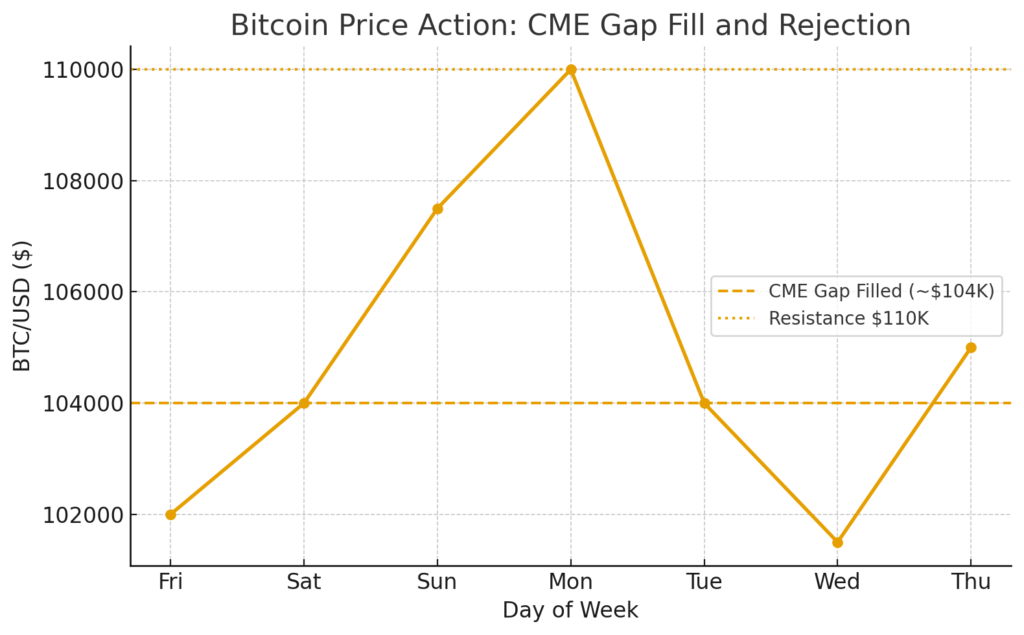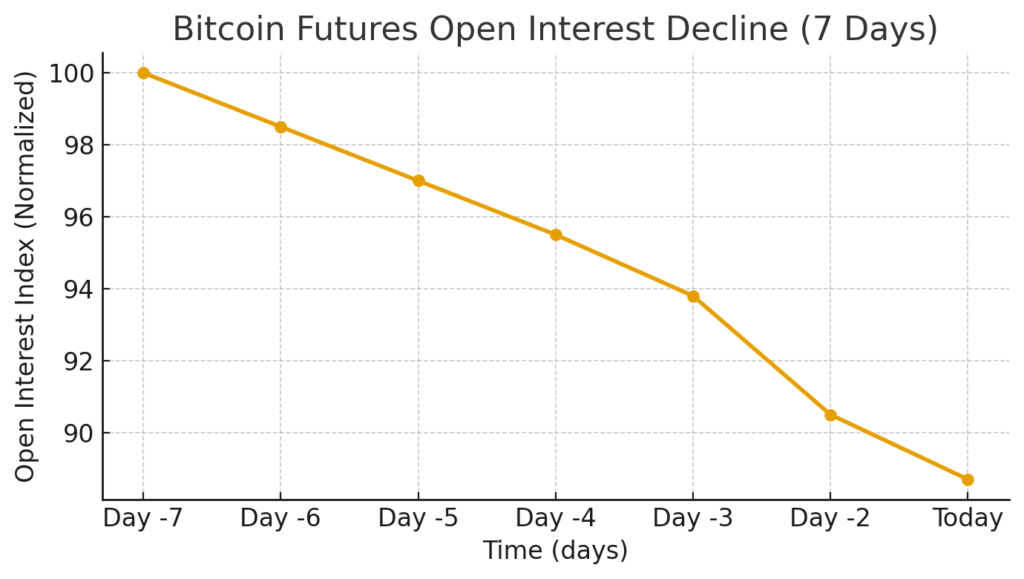
Main Points :
- The flagship crypto Bitcoin (BTC) filled the entity[“organization”, “CME Group”, 0] futures “gap” around $104,000, yet failed to rally through $110,000 due to large-scale selling.
- On-chain and derivatives data show whales off-loading roughly $240 million in BTC, and open interest (OI) in futures is down more than 11% — a de-risking signal historically preceding recovery.
- Traders are closely watching the $100,000 psychological level and the $104,000–$110,000 range for key support/resistance.
- For investors hunting new crypto assets, revenue sources, or practical blockchain applications: the current consolidation may present long-term entry opportunities, but caution is warranted given the short-term volatility.
1. Gap Filled but Momentum Halted

Over the weekend and into early trades this week, Bitcoin filled a widely-tracked futures gap on the CME between approximately $104,000 and $110,000. That gap had formed when the CME futures market closed for the weekend, allowing spot markets to move while futures were offline.
The logic is that when the price “jumps” over the CME close-to-open discontinuity, a “gap” forms—technically, a price region where no trading occurred on the futures contract. Many traders believe such gaps tend to be revisited (“filled”) at a later point. In this case, BTC’s spot/ futures price retraced into the gap zone, which many took as a bullish sign.
However, despite the gap fill, BTC did not continue streaming upward through the next resistance zone (~$110,000). According to data from Material Indicators and order-book flows, a ~$240 million sell-off by large holders occurred near the ~$104 k mark, preventing a breakout.
Thus, while the gap fill is often considered a technical bullish trigger, in this instance it functioned more like a magnet attracting price, but the subsequent buying power failed to push beyond the nearby ceiling.
2. Whale Selling and Derivatives De-Risking
A deeper look at market structure reveals reasons why the rebound stalled. On-chain and derivatives metrics paint a picture of risk-aversion rather than aggressive accumulation.
Whale selling
Order-book and on-chain data show concentrated selling by large stakeholders (“whales”) around the $104 k region. This aligns with commentary that the local high was targeted by those exiting positions rather than initiating fresh long exposure.
Open Interest collapse
The derivatives markets are showing a clear drop in interest: for example, the on-chain analytics platform CryptoQuant reports more than an 11 % decline in open interest (OI) over the past week.
In its “Quicktake” blog, contributor GugaOnChain interprets this decline as a systematic de-leveraging, where traders reduce speculative risk. Historically, such OI reduction has preceded recovery phases.

Implications for new asset seekers
For investors hunting for the next breakout crypto or seeking passive income opportunities, this mixed structure (gap filled + whales selling + OI down) suggests caution. The market may be consolidating rather than trending upward. That said, if the base formation holds and risk sentiment returns, the current environment might represent a long-term buying window.

3. Key Support/Resistance Levels and Market Sentiment
With the above dynamics in play, price levels and sentiment become crucial to watch.
Support levels
- $100,000: A key psychological anchor. Many traders now treat this as a demand zone.
- Below $100,000: Some analysis suggests that if $104 k fails, a drop toward $101,000–$102,500 may occur.
Resistance
- ~$110,000: The upper range of the CME gap and immediate ceiling. Failure to surpass this range diminishes breakout odds.
- Local high ~$107,500: Previous high this month where BTC topped out.
Sentiment indicators
- The drop in open interest signals less speculative fervour, which can be good (less overheating) but also indicates fewer “hot money” tails to push price higher quickly.
- A reduction in speculative leverage tends to yield more sustainable rallies, albeit slower.
- On the macro side, the broader market risk-tone improved as U.S. equities recovered and the government shutdown showed signs of ending. That helped BTC bounce near $105,000 on Monday.
For blockchain-practical players
If you’re looking into blockchain applications (wallets, swaps, DeFi), environments where volatility is lower and leverage is reduced may offer more stable entry points. Overheated markets can favour speculation; this consolidation may favour projects that demonstrate real fundamentals (e.g., non-custodial wallets, token utilities) rather than pure momentum trades.
4. What This Means for New Crypto Assets and Income Strategies
Given this context, how should one think about new crypto assets, revenue opportunities, and blockchain use-cases?
New crypto assets
- Risk capital: The current state suggests less dramatic upside in the flagship BTC near-term, so diversifying into high-potential altcoins (with real use cases) may make sense.
- Timing: Waiting for confirmation of breakout (BTC above $110k) or strong base support (BTC holding above $100k) might reduce downside risk.
- Utility focus: Assets tied to practical blockchain infrastructure (swaps, wallets, DeFi revenue-generating tokens) may be more resilient in this environment than pure hype assets.
Revenue opportunities
- Derivatives risk remains elevated: Given the reduced open interest and leveraged positions, strategies that rely solely on momentum may underperform.
- Yield strategies: With speculation thinning, yield-oriented projects (staking, tokenised revenue streams, infrastructure fees) may gain relative attractiveness—but always with due diligence on protocol risk.
- Market cycles: The deleveraging phase often precedes the next leg up—investors who conserve capital now may benefit when momentum returns.
Practical blockchain applications
- Non-custodial solutions: As institutional flows build and spot holdings increase (see reports of accumulation), projects facilitating secure self-custody may gain user adoption.
- Token swap/on-ramp tools: With volatility subdued, user-friendly tools enabling ETH↔BTC swaps or cross-chain flows could see uptake.
- Data/analytics: Given heavy emphasis on metrics like OI, gaps, funding rates—the market is maturing. Projects offering actionable analytics could capture demand.
5. Summary and Outlook
In summary: While Bitcoin’s CME futures gap around $104,000-$110,000 has been filled—technically a bullish sign—the market structure isn’t confirming an immediate breakout. Whale selling of ~$240 million has weighed on momentum, and open interest’s >11% drop signals reduced speculative levered exposure. Support around $100,000 is now critical, and the ceiling near $110,000 remains a barrier for now.
For readers seeking new crypto assets and practical blockchain playbooks: this environment suggests consolidation rather than rally. That means higher discipline, more selective entry, and leaning toward utility-driven projects might serve you better than chasing the next flash run.
If Bitcoin holds above $100 k and risk sentiment improves, the stage may be set for the next leg up—making this a potentially favourable entry moment for those with a longer-term horizon. Conversely, a breakdown below support would warrant caution and a potential shift toward defensive positioning.

